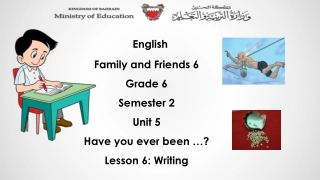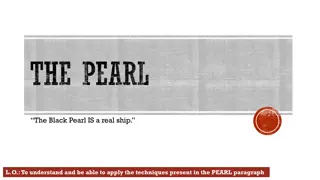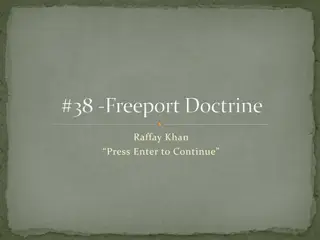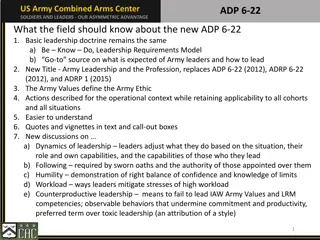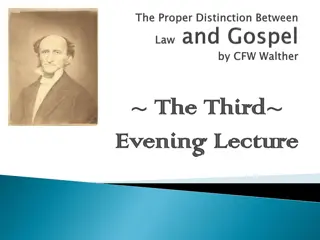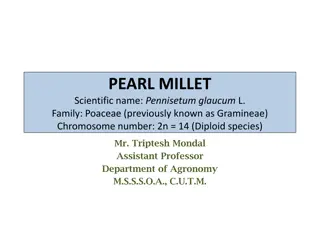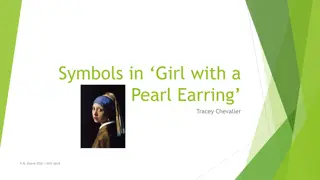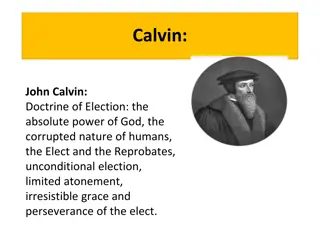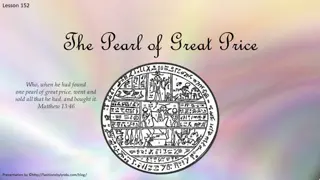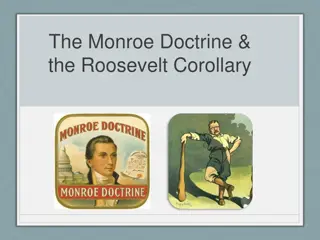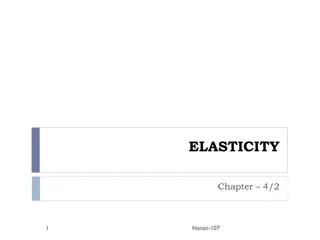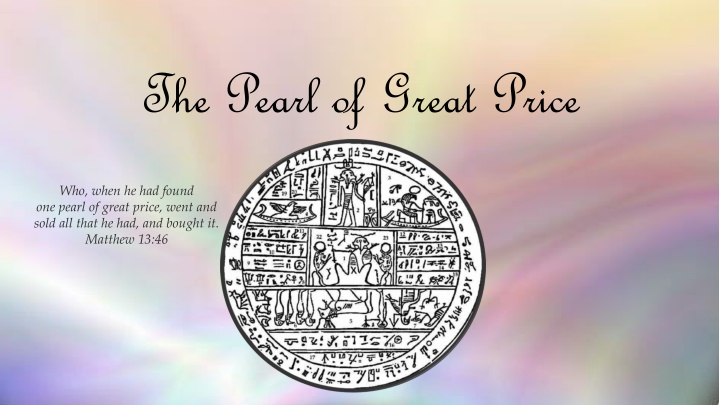
Insights into the Pearl of Great Price
Explore the origins and contents of the religious text known as the Pearl of Great Price, including its significance, translations, and key writings such as the Book of Moses and Book of Abraham. Learn about its acceptance as scripture in the Church of Jesus Christ of Latter-day Saints and the revisions it underwent over the years.
Download Presentation

Please find below an Image/Link to download the presentation.
The content on the website is provided AS IS for your information and personal use only. It may not be sold, licensed, or shared on other websites without obtaining consent from the author. If you encounter any issues during the download, it is possible that the publisher has removed the file from their server.
You are allowed to download the files provided on this website for personal or commercial use, subject to the condition that they are used lawfully. All files are the property of their respective owners.
The content on the website is provided AS IS for your information and personal use only. It may not be sold, licensed, or shared on other websites without obtaining consent from the author.
E N D
Presentation Transcript
The Pearl of Great Price Who, when he had found one pearl of great price, went and sold all that he had, and bought it. Matthew 13:46
The Pearl of Great Price In 1851, Elder Franklin D. Richards, a member of the Quorum of the Twelve Apostles and the president of the British Mission, published several revelations, translations, and writings of Joseph Smith and called the collection the Pearl of Great Price. Assembly Hall 1888 finished in 1880 During a general conference of the Church in October 1880, the Church accepted the Pearl of Great Price as scripture part of the standard works. The Pearl of Great Price is a selection of choice materials touching many significant aspects of the faith and doctrine of The Church of Jesus Christ of Latter-day Saints Introduction to the Pearl of Great Price
Where does the name come from? A pearl is produced inside an oyster as the oyster responds to the irritation of foreign matter, such as a grain of sand. The oyster produces a substance to surround the grain, which eventually forms a pearl. Natural pearls are rare and are considered precious.
What is in the Pearl of Great Price? The Book of Moses or Selections from the Book of Moses consists of several revelations given to Joseph Smith while he was revising the Bible under inspiration, beginning in June 1830. The Book of Abraham contains writings of Abraham, and it is a translation from some Egyptian papyri that the Church obtained in 1835. It includes a record of the life of the patriarch Abraham and also a description of the creation of the world that is similar to that recorded in Genesis and in the Book of Moses. Joseph Smith-Matthew is an extract from the testimony of Matthew taken from Joseph Smith's translation of the Bible. Joseph Smith-History includes excerpts from Joseph Smith's official testimony and history, which he prepared in 1838. The Articles of Faith of The Church of Jesus Christ of Latter-day Saints include thirteen untitled statements previously published in the Times and Seasons in March 1842. Mormonwiki
Revisions 1976 1878 1902 1979 1921 Two items of revelation were added Certain parts of Pearl of Great Price that were duplicated and published in D&C were omitted and Arrangements into chapters and verse, with footnotes Double-column pages with index The items removed were placed in D&C 137 and 138 Portions of Book of Moses not contained in first edition were added
Book of Abraham Joseph Smith began the translation in 1835 after obtaining some Egyptian papyri. The Book of Abraham. An inspired translation of the writings of Abraham. The translation was published serially in the Times and Seasons beginning March 1, 1842, at Nauvoo, Illinois.
Why did Joseph Smith say he had translated the writings of Abraham even though the manuscripts do not date from Abraham s time? The Prophet Joseph Smith never claimed the papyri were indeed the writings of Abraham. He said the book of Abraham was a translation of some ancient Records that have fallen into our hands, from the Catacombs of Egypt, purporting to be the writings of Abraham, while he was in Egypt. Times and Seasons In 1966 eleven fragments of papyri once possessed by the Prophet Joseph Smith were discovered in the Metropolitan Museum of Art in New York City. They were given to the Church and have been analyzed by scholars who date them between about 100 B.C. and A.D. 100. A common objection to the authenticity of the book of Abraham is that the manuscripts are not old enough to have been written by Abraham, who lived almost two thousand years before Christ. Joseph Smith never claimed that the papyri were autographic (written by Abraham himself), nor that they dated from the time of Abraham. It is common to refer to an author s works as his writings, whether he penned them himself, dictated them to others, or others copied his writings later. (The Pearl of Great Price Student Manual, 28).
What happened to the mummies and the papyri? After the death of the Prophet Joseph Smith, the four mummies and the papyri became the property of Joseph s widowed mother, Lucy Mack Smith (The Pearl of Great Price Student Manual, 29). After Lucy Mack Smith died, the collection was sold to a man named Abel Combs. The collection may have been sold by Joseph Smith s wife Emma, or it may have been sold by his brother William. Mr. Combs sold some of the collection to a museum in St. Louis, Missouri. He retained other portions and later gave some of them away. (See The Pearl of Great Price Student Manual, 29; H. Donl Peterson, The Story of the Book of Abraham: Mummies, Manuscripts, and Mormonism [1995], 204 9, 257.) Several theories have been offered regarding what happened to the mummies and the papyri. It appears that at least two of the mummies were burned in the great Chicago fire of 1871. (see B. H. Roberts, New Witnesses for God, 3 vols. [1909 11], 2:380 382).
In the early spring of 1966, Dr. Aziz S. Atiya, a University of Utah professor, [brought to the attention of the Church several fragments of the Joseph Smith papyri that were located] at the Metropolitan Museum of Art in New York City. These fragments were presented to the Church by the director of the museum on 27 November 1967. The current whereabouts of the other mummies and the other portions of the papyri are unknown. Some Joseph Smith Papyri was Rediscovered (1967). Studies in Scripture
Book of Matthew Joseph Smith Matthew. An extract from the testimony of Matthew in Joseph Smith s translation of the Bible (see Doctrine and Covenants 45:60 61 for the divine injunction to begin the translation of the New Testament).
Joseph Smith History Joseph Smith History. Excerpts from Joseph Smith s official testimony and history, which he and his scribes prepared in 1838 1839 and which was published serially in the Times and Seasons in Nauvoo, Illinois, beginning on March 15, 1842.
Articles of Faith Joseph Smith wrote a letter to John Wentworth, editor and proprietor of the Chicago Democrat, an Illinois newspaper. In the letter the Prophet Joseph Smith gave an account of the doctrines and history of the Latter-day Saints. The Articles of Faith were a part of that letter. For the text of the entire letter. The Articles of Faith of The Church of Jesus Christ of Latter-day Saints. A statement by Joseph Smith published in the Times and Seasons March 1, 1842, in company with a short history of the Church that was popularly known as the Wentworth Letter. Ensign July 2002
Help us fall in love! You will be assigned one book in the Pearl of Great Price. You have 10 minutes to study and find one passage that will be life changing to someone in our class: 1.The Book of Moses 2.The Book of Abraham 3.Joseph Smith-Matthew 4.Joseph Smith History 5.The Articles of Faith

